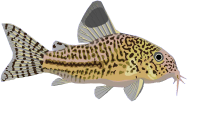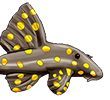| Scientific Name | Corydoras amapaensis Nijssen, 1972 |
| Common Names | CW121, Amapa State Cory Amapa Cory, Pirate Cory, Piratpansermalle (Denmark) |
| Type Locality | Cachoera Creek at right bank of Rio Amapari, 4 km downstream of Casa do 7, Amapa, Brazil. |
| Pronunciation | kor ee doh rass. - ah map ah ENN siss |
| Etymology | Cory = helmet, doras = skin. In this case it was incorrectly used to mean armour (cuirasse) instead of skin in allusion to the dual rows of plates that run along the flanks of this genus. From Amapa, the state in Brazil where the species was found. Latin ensis denoting a place, locality or country. |
| Articles | |
| Size | 70mm or 2.8" SL. Find near, nearer or same sized spp. |
| Identification | Corydoras are identified by their twin rows of armour plates along the flanks and by having fewer than 10 dorsal fin rays. They are most commonly confused with the other genera in the sub-family, namely Brochis, Scleromystax and Aspidoras. The colour pattern of this species varies considerably throughout its range and, because of this fact, it is often confused with the following species. C. septentrionalis originating from Venezuela, C. simulatus originating from Colombia and both C. treitlii and C. solox which were described from Brazil. C. amapaensis differs from all but C. septentrionalis by the presence of a third pair of rictal barbels - see the catfish of the month article for more info. and pictures. There is no easy way to distinguish C. amapaensis from C. septentrionalis, the former attain a slightly larger adult size and have a more rugged appearance than the latter. Although as youngsters they both have a light banding in their caudal fins, adult C. amapaensis have clear caudal fins. |
| Sexing | As with all Corys, the female is larger, plumper and has rounded pelvic fins. |
| Distribution | South America: Oyapock and Amapari rivers in Amapá, Brazil and French Guiana. Amapa State Waters, Araguari (Amapa), Amapari (click on these areas to find other species found there) Guyana Waters, Coastal Rivers of Guyanas, French Guyana Coastal Rivers, Oyapock (click on these areas to find other species found there) Login to view the map. |
| IUCN Red List Category | Least Concern , range map and more is available on the IUCN species page. Last assessed 2020. |
| pH | 6.0 - 7.6 |
| Temperature | 23.0-28.0°C or 73.4-82.4°F (Show species within this range) |
| Other Parameters | Water should be a little soft. |
| Feeding | All suitably sized foods. Bloodworm & brineshrimp are particular favourites. User data. |
| Furniture | Floating plants to diffuse lighting and a sandy substrate is an almost must for this digger. |
| Compatibility | As with all Corys, a perfect community tank citizen. Males, once established, can be quarrelsome with each other if kept in too small an aquarium. |
| Suggested Tankmates | Anything from tetras to cichlids, preferably South American, but will mix with all community fish. |
| Breeding | Unreported. |
| Breeding Reports | There is no breeding report. |
| Reference | Netherlands Journal of Zoology v. 21 (no. 4), pp 417, Figs. 2, 3; Pl. 3. |
| Registered Keepers | There are 7 registered keepers, view all "my cats" data. |
| Wishlists | Love this species? Click the heart to add it to your wish list. There are 3 wishes to keep this species, see who wants what. |
| Spotters | Spotted this species somewhere? Click the binoculars! There are 5 records of this fish being seen, view them all. |
| Forum BBCode | |
| Search for C. amapaensis | |
| Look up C. amapaensis on AquaticRepublic.com | |
 | Look up C. amapaensis on Fishbase |
 | Look up C. amapaensis on Encyclopedia of Life |
 | Look up C. amapaensis on Global Biodiversity Information Facility |
| LFS label creator ARN ref:1.1.686.9 | |
| Last Update | 2025 Jan 02 01:37 (species record created: 2004 Apr 27 00:00) |





/siluriformes/callichthyidae/corydoras/amapaensis/1.jpg)
/siluriformes/callichthyidae/corydoras/amapaensis/2.jpg)
/siluriformes/callichthyidae/corydoras/amapaensis/3.jpg)
/siluriformes/callichthyidae/corydoras/amapaensis/4.jpg)
/siluriformes/callichthyidae/corydoras/amapaensis/5.jpg)
/siluriformes/callichthyidae/corydoras/amapaensis/6.jpg)